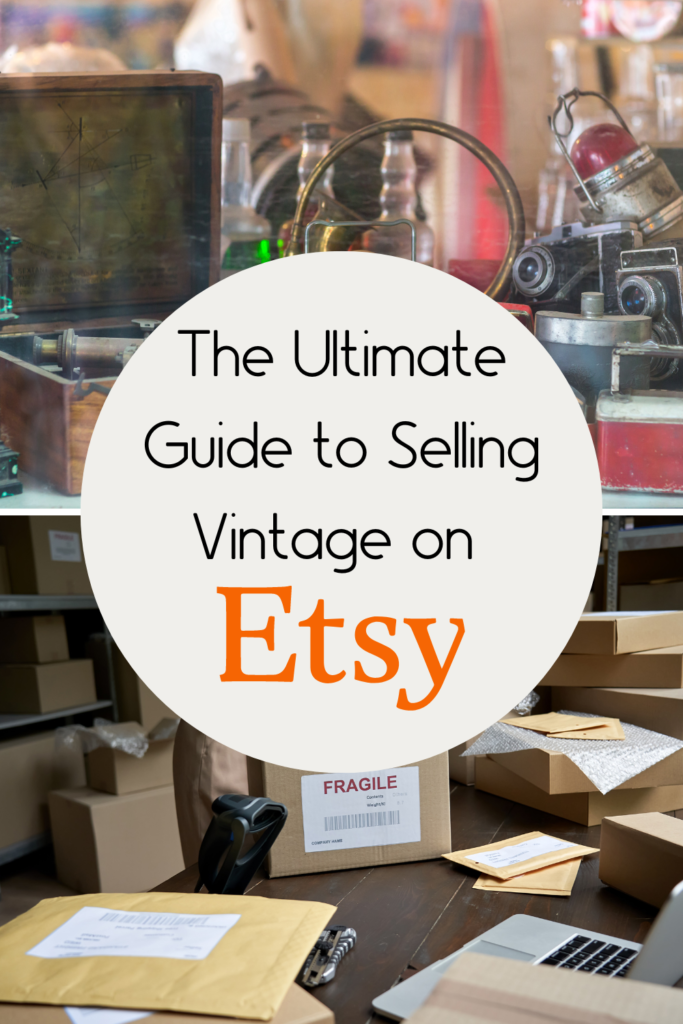Hello, budding vintage entrepreneurs! Are you ready to venture into the exciting world of selling vintage on Etsy? If so, you’re in the right place! Let’s dive into this step-by-step guide to get you started:
7 Steps to Selling Vintage on Etsy
Step 1: Identify Your Niche
Your first step is to identify the type of vintage items you want to sell. Are you passionate about vintage clothing, antique furniture, retro toys, or old-school vinyl records? Perhaps you’re smitten by all things 80s or the glamour of Hollywood Regency style? Your niche should ideally align with your personal passions.
When your niche is something you’re truly passionate about, you tend to have a deeper knowledge about those items. This knowledge becomes a natural advantage in identifying valuable pieces, understanding their history, and communicating their worth to potential customers.
Moreover, passion fuels curiosity, and when you’re genuinely interested in your niche, you’ll find yourself eagerly researching items, staying abreast of trends, and continuously expanding your expertise.
Choosing a niche that resonates with your personal interests doesn’t just make your Etsy journey more enjoyable; it makes it more authentic, more enriching, and ultimately, more successful.
Your passion will shine through in every aspect of your shop, from the items you list to the descriptions you write, creating a unique and engaging experience for your customers.
Step 2: Source Your Vintage Items
Now comes the exciting part – hunting for your vintage treasures!
Yard sales, estate sales, vintage markets, thrift stores, and online marketplaces are all great places to start.
Check out this blog post for a deeper dive into the best places to find vintage items, along with tips to help you find authentic vintage items in great condition.
Remember, the definition of vintage on Etsy is anything that’s at least 20 years old. This means before you can sell an item on Etsy you will need to be able to confirm that it is indeed at least 20 years old.
Keep this in mind while you are hunting for vintage goods to sell and don’t purchase any vintage items that you can’t confirm the age.
This step is essential to maintaining trust with your customers and complying with Etsy’s policies. This will save you a lot of headaches and money lost on inventory you can’t sell.
Step 3: Set Up Your Etsy Shop
Setting up your Etsy shop is a straightforward process.
You’ll need to provide some basic information about your business, create a memorable shop name, and design a banner and logo that reflect the style of your shop.
For a really great FREE online graphic design tool to help you design your Etsy banner and logo, check out Canva.com
Check out this great tutorial for setting up an Etsy Shop.
Step 4: Take Great Photos
You are almost ready to list your items for sale and start making money on rehoming vintage treasures.
But before you can do that you have to take photos that let the charm of these vintage treasures shine through. Good photography is crucial – make sure your photos are clear, well-lit, and showcase the item from various angles.
Replica Surfaces offers hyper-realistic photography backdrop surfaces that can truly enhance your product photos, making them stand out from the crowd.
However, if you’re not quite ready to invest in professional photography surfaces, don’t worry! Replica Surfaces’ YouTube channel is packed with handy tips and tricks to help you snap stunning photos even without specialized equipment.
In addition to highlighting the beauty of your vintage items, it’s also essential to showcase any significant wear or damage.
Don’t make your buyers play eye spy – be transparent about any imperfections in your items.
While vintage lovers often expect a certain degree of wear and tear, they appreciate honesty about the item’s condition.
Remember, your transparency not only helps avoid potential disputes but also builds trust with your buyers, which is crucial for your success on Etsy.
Step 5: List Your Items
It’s time to showcase your vintage finds to the world. Crafting effective listings is a crucial step in your Etsy journey, and there are several key elements to consider when creating one.
- Title: Write a strong, descriptive title that includes words and phrases buyers would use when searching for your item. The first few words of your listing title have a particularly significant influence on Etsy search results. Focus on placing relevant terms that accurately represent your item and would be used by potential buyers in their search queries.
- Category: Pick a relevant category that accurately reflects your item. This helps Etsy’s search algorithm understand what you’re selling and ensures your listing appears in the appropriate search results.
- Tags: Utilize all 13 tags to describe your item effectively. A tag is a word or short phrase that represents your item, and Etsy uses these tags to match listings with shoppers’ searches. Including a variety of relevant tags improves the visibility of your item and increases the likelihood of it appearing in a potential buyer’s search results.
- Pricing: Price your item competitively by researching similar items on Etsy to get an idea of the price range. Consider factors such as condition, rarity, and demand when determining your price. Pricing your items within the range of comparable items on Etsy will help attract potential buyers while also ensuring you receive fair compensation for your vintage treasure.
Remember, Etsy’s search system considers listing titles, categories, and tags to determine the relevance of your item to a buyer’s search query. By optimizing these elements, you can increase the visibility of your listings and improve the chances of connecting with the right buyers.
Step 6: Promote Your Shop
Once your shop is up and running, it’s time to get the word out!
Use social media, Pinterest, SEO strategies, and Etsy’s promotional tools to drive traffic to your shop. You might also consider offering a grand opening sale or coupon codes to attract your first customers.
Step 7: Provide Excellent Customer Service
Last but definitely not least, always strive to provide excellent customer service.
Respond to inquiries promptly, ship items quickly and well-packaged, and handle any issues professionally.
Happy customers often lead to positive reviews, which can significantly boost your shop’s reputation.

Embarking on Your Vintage Etsy Shop Adventure
Starting a vintage Etsy shop can be an exciting and profitable venture if you’re willing to put in the time and effort. As with any business, there will be challenges along the way, but with passion, patience, and persistence, you can build a successful vintage shop on Etsy. Happy selling, vintage enthusiasts!
Stay tuned to the Vintage Academy for more tips, tricks, and advice on your vintage selling journey. Until next time, keep hunting for those hidden gems!


You were referred to me by Jeanne,
I have two shops on Etsy, theeclecticbazzar (antiques, vintage, eclectic, jewelry and then Pawtonabbey (dedicated to dog and cat vintage, antique and accessories) .
The Eclecticbazzar shop does OK, but I need assistance with SEO, Pinterest, Facebook and Instagram are Greek to me. I had a FB page and it was hacked and am trying to set up Business pages, tried it myself and it all needs some serious HELP.
I know that need to have more items in my shops, but life gets in the way.
An going to check out your courses, but any suggestions or assistance would be greatly appreciated.
Thank in advance,
Victoria
Hello! If you head on over to https://vintageacademy.podia.com/ there are some resources there that may help or you can email me (link in the ABOUT ME section) and I would love to see what I can do to help.